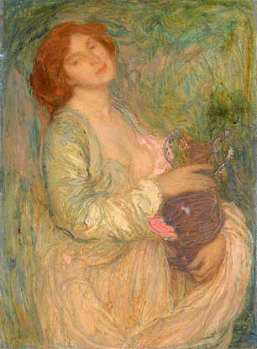The views expressed in our content reflect individual perspectives and do not represent the authoritative views of the Baha'i Faith.
…in the search for truth man must weigh religious questions in the balance of science and reason. God has given us rational minds for this purpose, to penetrate all things, to find truth. – Abdu’l-Baha, Divine Philosophy, p. 102.
Imagine this: what if you had the opportunity to sit down with one of the living leaders of a great worldwide Faith and spend hours asking your burning, innermost questions about the meaning of life? In modern terms, think about having that kind of access to the mind and spirit of the Dalai Lama or the Pope; and you’ll get some small sense of how the unique and historic Baha’i book Some Answered Questions came about.

Painting of Laura Barney
Laura’s mother was Alice Pike, daughter of entrepreneur Samuel Pike, a multi-millionaire. Laura grew up in the lap of luxury and led a privileged life. Raised by French governesses and educated by private tutors, Laura hailed from a socially prominent family of artists and scholars. Around the turn of the century, when Laura had just turned 21, she moved with her family to Paris to continue her studies. There she met a spirited, lively Canadian Baha’i named May Bolles, who first told her about the Baha’i Faith.
In 1904, Barney traveled to Palestine to visit Abdu’l-Baha in Akka (across the bay from Haifa, the site of the Baha’i World Centre). It was her third trip to Palestine, in fact. In successive visits between 1904 and 1906, Barney learned Persian, while closely interacting with members of Abdu’l-Baha’s household.
Over time, Barney posed a number of questions to Abdu’l-Baha, usually over dinner, when he would take time out from his busy schedule to respond. The questions mainly focused on philosophy, science, Christian theology, matters of soul and spirit, and several controversial social issues. Laura Barney had this to say about her remarkable experience:
“I have given to you my tired moments,” were the words of Abdu’l-Baha as He rose from table after answering one of my questions…
During my several visits to Akka, these answers were written down in Persian while Abdu’l-Baha spoke, not with a view to publication, but simply that I might have them for future study. At first they had to be adapted to the verbal translation of the interpreter; and later, when I had acquired a slight knowledge of Persian, to my limited vocabulary. This accounts for repetition of figures and phrases, for no one has a more extensive command of felicitous expressions than Abdu’l-Baha. In these lessons He is the teacher adapting Himself to His pupil, and not the orator or poet. – Laura Clifford Barney, “Author’s Preface to the First Edition,” Some Answered Questions (2015 edition).
Abdu’l-Baha’s answers to Laura’s questions were taken down by his secretaries in Persian. He subsequently reviewed and, with his red pen, edited these notes as needed, then signed and stamped each edited discourse with his seal, indicating his approval for eventual publication. This careful editing effectively transformed the collection of discourses that comprised Some Answered Questions from an informal Q&A session into an authoritative Baha’i text. The original Persian texts are archived in the Baha’i World Centre in Haifa, Israel.
Later, Laura Barney, with her future husband, Hippolyte Dreyfus (1873–1928, the first French Baha’i), collaborated on editing and translating these answers in the form of a book. Laura translated the Persian text in 1908 and published the book in the Netherlands, with the English translation published in London, followed by the French translation, published in Paris in 1909. Instantly the book became well-known all over the world.
It was love “at first book.” On April 15, 1911, Laura and Hippolyte had their Baha’i wedding and adopted the surname, Dreyfus-Barney.
Over time, it became increasingly apparent that Laura Barney’s original translation, although adequate for its purposes, could benefit from a highly skilled re-translation. The “Foreword” to the new translation of SAQ clearly states the translation objectives:
The main objective of this retranslation has been to better represent the substance and the style of the original, in particular by capturing more clearly the subtleties of Abdu’l-Baha’s explanations, approximating more closely a style that is at once conversational and elevated, and by rendering more consistently the philosophical terms used throughout the text. While not bound by the original translation, this version nevertheless strives to retain many of its elegant expressions and felicitous turns of phrase. – “Foreword,” Some Answered Questions (2015 edition).
Now the new translation has been printed, and it offers us a fascinating window into the Baha’i teachings. Would you like to read the new translation and discuss it? Then why not enroll in an upcoming Wilmette Institute course that starts on July 10? (You can even register for it a few days after that date.) With three experienced faculty members, and enthusiastic interest in this new translation among participants, you’re sure to experience a lively “learning dynamic” throughout this eight-week course.
What to expect? Here’s the course schedule:
Unit 1: Getting Started (July 10–13, 2015).
Unit 2: On the Influence of the Prophets in the Evolution of Humanity (July 14–20).
Unit 3: On the Influence of the Prophets in the Evolution of Humanity (July 21–27).
Unit 4: Some Christian Subjects (July 28–August 3).
Unit 5: On the Powers and Conditions of the Manifestation of God (August 4–10).
Unit 6: On the Origin, Powers and Conditions of Man (August 11–17).
Unit 7: On the Origin, Powers and Conditions of Man (August 18–24).
Unit 8: Miscellaneous Subjects (August 25–31).
Unit 9: Application and Integration (September 1–3).
You can now find the entire text of the newly revised Some Answered Questions online.
You May Also Like
Comments

















Judging from the fact that Some Answered Questions (SAQ) by ‘Abdu’l‐Bahá is "Collected and translated from the Persian by Laura Clifford Barney" and "Newly Revised by a Committee at the Bahá’í World Centre," we can surmise that this is an authorized translation. So, in a sense, that's the first measure of this translation's "authority" (for Baha'is). Both the Persian original and ...English translation are further represented as "authoritative" in the "Foreword," which states:
"The main objective of this retranslation has been to better represent the substance and the style of the original, in particular by capturing more clearly the subtleties of ‘Abdu’l-Bahá’s explanations, approximating more closely a style that is at once conversational and elevated, and by rendering more consistently the philosophical terms used throughout the text. While not bound by the original translation, this version nevertheless strives to retain many of its elegant expressions and felicitous turns of phrase. Since its release, Some Answered Questions has been an authoritative repository of ‘Abdu’l-Bahá’s profound insight and an indispensable component of every Bahá’í library."
That said, since the newly revised translation makes no claims to being an infallible translation, then the Persian original (as with original documents in most any case) is more authoritative than the otherwise excellent, yet theoretically imperfect, newly revised English translation.
There may be an argument that Shoghi Effendi's translations (considered by Baha'is to be infallibly inspired in an interpretative sense) may offer an exception to this general rule. It has often been said by native readers of Arabic that Shoghi Effendi's authorized translations effectively disambiguate otherwise difficult passages in the Arabic originals, and render their meanings more accessible and precise.
In those cases, I would say that the most "authoritative" reading is to consult both the Arabic original and Shoghi Effendi's translations together. This is not to equate the Arabic original (if one of Baha'u'llah's revelations) with the translation itself, for the simple reason that a translation always involves interpretation, when going from the source language to the target language.